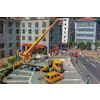Traylor Bros. Inc.’s initial efforts to improve equipment performance uncovered and dealt with a lot of machine safety issues. As the company’s equipment-division employees developed procedures for project-level audits of equipment quality, they also started seeing ways to efficiently assess and grade overall project safety.
“A large portion of our recordable incidents over the years have been associated with operator access and egress and technician injuries,” says Thad Pirtle, vice president of equipment at the Evansville, IN,-based infrastructure contractor. “You take care of the small near misses and the incidents, and the recordables will go away.”
The company gathers its equipment professionals and operations people annually for an equipment quality meeting to discuss issues, assess progress and identify safety initiatives to work on for the coming year. The group picks the initiatives to pursue.
“We ask, ‘What’s the biggest pain in your day for the next year?’ I’ll write it down the answers we get and send ‘em back out in an email to the group,” says Pirtle. “We find a champion for each one of them. Next year, we’ll expect them to do a presentation on what they’ve done to address the safety issue.”
The group has been working through access and egress issues on various machine types, for example, for years.
“The more we get into it, the more we see needs to be improved,” says Pirtle. “Much of the change is actually coming through the design process, getting equipment manufacturers involved in the solutions. For instance, instead of putting fall-protection hookups on top of the crane where technicians have to go to inspect and maintain it, we get the manufacturers to put handrails around it.
“How do you wash the window on top of a crane cab? It’s above 6 ft., and there’s nowhere you can tie off,” says Pirtle. “We designed a window that drops down inside the cab so you can clean it off and put it back up without climbing.”
Taylor Bros.’ crane-intensive bridge, tunnel and dam business encourages the connection between equipment and safety. The company requires its project engineers, superintendents and field managers (more than 100 people) to pass the written part of the NCCCO crane-inspector certification. It’s partly because the Traylor equipment-quality program depends on machine inspections conducted on cranes when they leave and arrive on projects.
“They’ve got to know No. 1 what’s expected of them, and No. 2 what’s right and what’s wrong,” says Pirtle. “Is that lacing bad? What’s the replacement criteria? You have to know the standards to pass the NCCCO test. In the standards are the measurement criteria for broken wires and wear in wire rope and that sort of thing. If you pass the NCCCO test, you know the standards. If you know the standards, you’re qualified to do a preliminary walk-around inspection on a crane.”
These inspections aren’t intended to satisfy crane-safety regulations, but they help the company keep safe, work-ready machines on job sites.
Site audits are another important crossover between equipment quality and safety. Pirtle adapted the equipment division’s process for quick whole-project inspections designed to rate overall equipment condition to get a similar evaluation of a site’s quality standards.
The company assembles a safety assessment committee made up of an equipment-division field person, a project engineer, and a project or operations manager to visit a project and conduct the safety assessment. They spend a day or two (Traylor works on big projects) assessing and rating the quality of the site’s compliance with key safety aspects such as ladder control and fall protection.
There are ratings for safety administration such as crane inspection records and proper OSHA reporting.
“They also talk individually to at least 20% of the craft people, with certain questions that we ask, and measure their responses,” says Pirtle. “Do you have safety meetings? Are you involved in them? Do you know where the MSDS book’s at? Do you have a safety committee? Who’s on it?
“When it’s all said and done, you have scores coming from three different areas – field, administration and personnel. That’s rolled up into one score that tells the jobsite if they meet our standards, need improvement, or are deficient,” Pirtle explains. “The committee sits down with project management and goes over that whole assessment – what was found, how it might be improved.
“It gets another set of eyes on project safety; their peers are measuring it.
“Our safety and quality are interconnected, as far as I’m concerned; joined at the hip,” Pirtle concludes. “If you have good safety you’ll have good quality, and vice a versa.”

![Hcm Ax Landcros Dual Branded Logo[25]](https://img.forconstructionpros.com/mindful/acbm/workspaces/default/uploads/2025/11/hcmaxlandcros-dual-branded-logo25.Qhg3vUCjoK.jpg?auto=format%2Ccompress&bg=fff&fill-color=fff&fit=fill&h=100&q=70&w=100)



![Hcm Ax Landcros Dual Branded Logo[25]](https://img.forconstructionpros.com/mindful/acbm/workspaces/default/uploads/2025/11/hcmaxlandcros-dual-branded-logo25.Qhg3vUCjoK.jpg?ar=16%3A9&auto=format%2Ccompress&bg=fff&fill-color=fff&fit=fill&h=135&q=70&w=240)









![Fcp Racatac Chair 10893876[1]](https://img.forconstructionpros.com/mindful/acbm/workspaces/default/uploads/2025/10/fcp-racatac-chair-108938761.10l0At5WXv.png?ar=16%3A9&auto=format%2Ccompress&bg=fff&fill-color=fff&fit=fill&h=135&q=70&w=240)